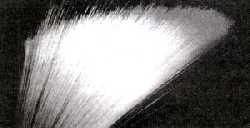Smooth drive
 the Achilles heel of optical fibre transmission has always been electronic switches that act as speed breakers to the flow of information. But Sergey Frolov and Valy Vardney of the University of Utah, Salt Lake City, have now developed optical switches that would enable data transmission at a high speed ( Physical Review Letters , 2 June, 1997).
the Achilles heel of optical fibre transmission has always been electronic switches that act as speed breakers to the flow of information. But Sergey Frolov and Valy Vardney of the University of Utah, Salt Lake City, have now developed optical switches that would enable data transmission at a high speed ( Physical Review Letters , 2 June, 1997).
Optical fibres are being used extensively in telecommunications. But, the access speeds and the bandwidths required today are not possible with the copper wires that form a majority of telecommunication networks. The extent of a band of frequencies is called band width. Conventional optical switches work on the principle that when an electric field is applied to certain crystals, their optical properties change. This can then be used to turn the light on or off. These switches can operate at speeds up to 20 gigahertz (20 billion times per second).
Vardney and colleagues have used derivatives of a compound ppv (p-pheylene vinylene) that can conduct electricity and also emit light. At present, these compounds are used to make polymers based lasers. The polymer is switched off by using a green laser. The laser pulse excites the electrons in materials and leaves behind vacancies called holes. The electrons and the holes form a structure called an exciton which then blocks infrared light by absorbing it. When the switch needs to be turned on, one can shine red light tuned to a precise frequency, which then forces the holes and the electrons to recombine, making the polymer transparent to the infrared beam.
The researchers have tested the set-up to about 100 mhz but foresee no theoretical problems in increasing the speeds to 1 trillion hertz. The limitations currently are from the laser set-up which is required to produce pulses at very high speeds.
There are several problems that need to be solved before the ppv based optical switches can be used commercially. A crucial block is the fact that the polymer rapidly degrades when repeatedly hit by the laser light. Also the polymer films absorb the infrared light and heat up, thus causing further degradation. The researchers are confident that these technical snags can be overcome and the field of optoelectronics is poised for a big revolution.
Related Content
- India’s long-term low-carbon development strategy
- Breather from Morbi’s noxious fumes
- Plantation drive to put UP into the Guinness Book of World Records
- Don't breathe here: tackling air pollution from vehicles
- India State of the Environment Report : The Monthly Overview, September 2013
- Highly charged motoring
